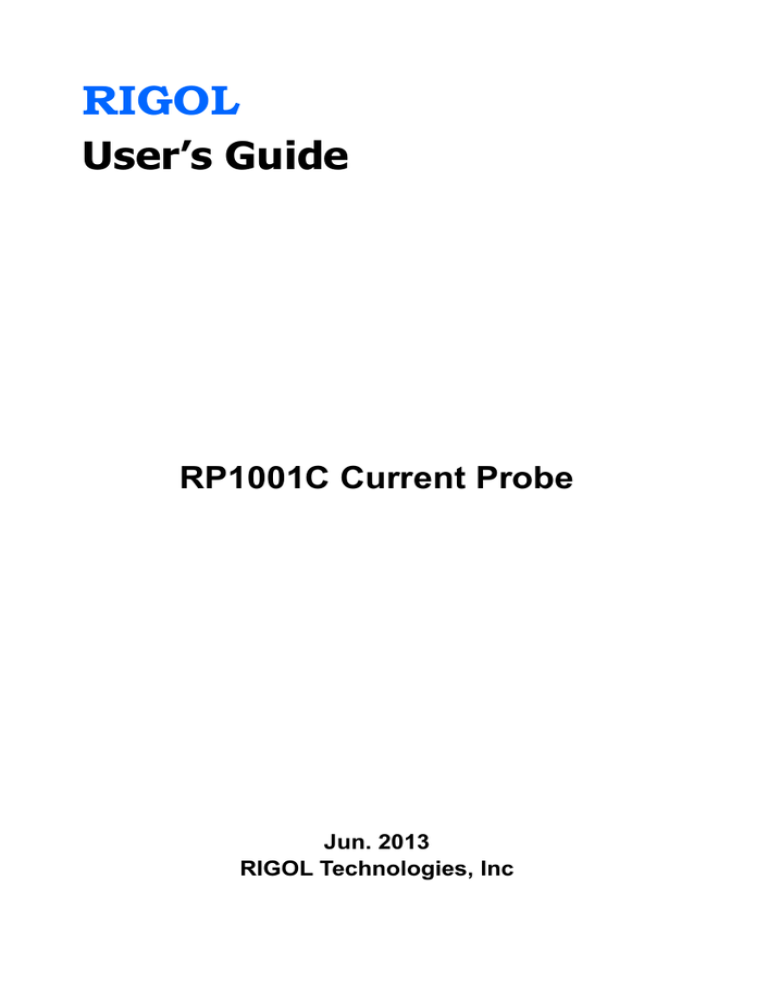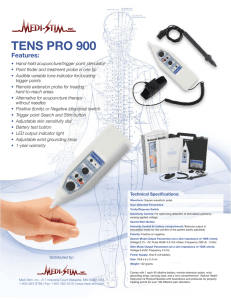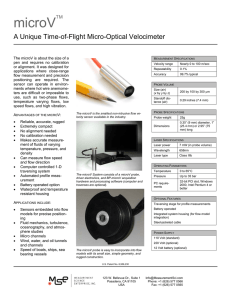
RIGOL
User’s Guide
RP1001C Current Probe
Jun. 2013
RIGOL Technologies, Inc
RIGOL
Guaranty and Declaration
Copyright
© 2012 RIGOL Technologies, Inc. All Rights Reserved.
Trademark Information
RIGOL is a registered trademark of RIGOL Technologies, Inc.
Publication Number
UGE16104-1110
Notices
RIGOL products are protected by patent law in and outside
of P.R.C.
RIGOL reserves the right to modify or change parts of or all
the specifications and pricing policies at company’s sole
decision.
Information in this publication replaces all previously
corresponding material.
RIGOL shall not be liable for losses caused by either
incidental or consequential in connection with the furnishing,
use or performance of this manual as well as any information
contained.
Any part of this document is forbidden to be copied or
photocopied or rearranged without prior written approval of
RIGOL.
Product Certification
RIGOL guarantees this product conforms to the national and
industrial standards in China as well as the ISO9001:2008
standard and the ISO14001:2004 standard. Other international
standard conformance certification is in progress.
Contact Us
If you have any problem or requirement when using our products,
please contact RIGOL Technologies, Inc. or your local distributors,
or visit: www.rigol.com.
RP1001C User’s Guide
I
RIGOL
General Safety Summary
Please review the following safety precautions carefully before
putting the instrument into operation so as to avoid any personal
injuries or damages to the instrument and any product connected
to it. To prevent potential hazards, please use the instrument only
specified by this manual.
Ground The Instrument.
The instrument is grounded through the Protective Earth lead of
the power cord. To avoid electric shock, it is essential to connect
the earth terminal of power cord to the Protective Earth terminal
before any inputs or outputs.
Observe All Terminal Ratings.
To avoid fire or shock hazard, observe all ratings and markers on
the instrument and check your manual for more information about
ratings before connecting.
Replace Fuse Properly
Make sure that no overvoltage (such as voltage caused by
thunderbolt) this product. Otherwise, the operator might be
exposed to electric shock.
Do Not Operate Without Covers.
Do not operate the instrument with covers or panels removed.
Avoid Circuit or Wire Exposure.
Do not touch exposed junctions and components when the unit is
powered.
II
RP1001C User’s Guide
RIGOL
Do Not Operate With Suspected Failures.
If you suspect damage occurs to the instrument, have it inspected
by qualified service personnel before further operations. Any
maintenance, adjustment or replacement especially to circuits or
accessories must be performed by RIGOL authorized personnel.
Keep Well Ventilation.
Inadequate ventilation may cause increasing of temperature or
damages to the device. So please keep well ventilated and inspect
the intake and fan regularly.
Do Not Operate in Wet Conditions.
In order to avoid short circuiting to the interior of the device or
electric shock, please do not operate in a humid environment.
Do Not Operate in an Explosive Atmosphere.
In order to avoid damages to the device or personal injuries, it is
important to operate the device away from an explosive
atmosphere.
Keep Product Surfaces Clean and Dry.
To avoid the influence of dust and/or moisture in air, please keep
the surface of device clean and dry.
Electrostatic Prevention.
Operate in an electrostatic discharge protective area environment
to avoid damages induced by static discharges. Always ground
both the internal and external conductors of the cable to release
static before connecting.
RP1001C User’s Guide
III
RIGOL
Safety Terms and Symbols
Terms in this Manual. These terms may appear in this manual:
WARNING
Warning statements indicate the conditions or practices
that could result in injury or loss of life.
CAUTION
Caution statements indicate the conditions or practices
that could result in damage to this product or other
property.
Terms on the Product. These terms may appear on the
Product:
DANGER
WARNING
CAUTION
indicates an injury or hazard may immediately
happen.
indicates an injury or hazard may be accessible
potentially.
indicates a potential damage to the instrument or
other property might occur.
Symbols on the Product. These symbols may appear on the
product:
Double
Insulation
IV
Safety
Warning
Protective
Earth
Terminal
Chassis
Ground
Test
Ground
RP1001C User’s Guide
RIGOL
Contents
Guaranty and Declaration ................................................... I
General Safety Summary ................................................... II
Safety Terms and Symbols ............................................... IV
RP1001C Overview ............................................................. 1
Basic Operation .................................................................. 1
Connection between the Current Probe and Oscilloscope ....... 1
Connection between the Current Probe and Digital Meter ...... 4
Maintenance ....................................................................... 5
Battery .............................................................................. 5
To Install the Battery .......................................................... 5
AC Power Adapter .............................................................. 6
Cleaning ............................................................................ 6
Preparation for shipment .................................................... 7
Specifications ..................................................................... 8
Electrical Characteristics ..................................................... 8
Voltage and Current Ratings ................................................ 9
Physical Characteristics ..................................................... 10
Environmental Characteristics ............................................ 10
Certifications and Compliances .......................................... 10
Accessories ....................................................................... 12
Appendix ........................................................................... 13
Appendix 1 Gain versus Frequency at 1 A Peak (Typical) ..... 13
Appendix 2 Maximum Current versus Frequency ................. 14
Appendix 3 DC Signal Linearity in 10mV/A Range (Typical) .. 14
Appendix 4 Phase versus Frequency at 1 A Peak (Typical) ... 15
RP1001C User’s Guide
V
RIGOL
RP1001C Overview
The RP1001C current probe enables a general purpose
oscilloscope to display AC and DC current signals up to 100 A Peak
(70 A RMS). The RP1001C current probe can also make AC and
DC measurements with a multimeter by using the BNC-to-banana
plug adapter.
Maximum Conductor Size: 11mm
Test Clamp Button
Test Clamp
BNC Interface
Battery Indicator
Overload Indicator
Zero Adjustment Knob
Range Switch
AC Adapter Input
Figure 1 RP1001C Current Probe
RP1001C User’s Guide
1
RIGOL
Control/Indicator
Description
Current flow symbol: The arrow shows
the positive direction of current flow
.
Zero adjustment: After connecting to
power and fixing the current probe to a
fixed position, rotate the knob to adjust
the probe output tothe proper DC offset. It
may also be used to offset a DC signal
component. Zeroing is not needed for AC
measurements unless your instrument
cannot isolate a DC component (if
present).
Range switch: Slide the switch from OFF
to either the 10 mV/A or 100mV/A range.
When 10 mV/A or 100mV/A is selected,
the probe is turned on, and the green
battery indicator (ON) lights..
Battery indicator: The green
battery/power indicator lights when the
probe is turned on. For more information,
please refer to To Install the Battery.
Overload indicator: The red overload
indicator lights and flicks continuously if
the measured signal is greater than the
maximum range of the selected range
capacity.
2
RP1001C User’s Guide
RIGOL
Basic Operation
Before using the current probe, the battery or specified AC power
adapter must be installed. For the battery installation instructions,
refer to To Install the Battery.
CAUTION
Do not clamp the probe onto circuits with voltages
greater than 600 VAC. Otherwise, personal injury or
damage to the probe may result.
CAUTION
Always connect the RP1001C current probe output to the
instrument before clamping onto the circuit under test.
Connection between the Current Probe and
Oscilloscope
1
Set the coupling mode of the oscilloscope to DC and connect
the BNC connector of the RP1001C current probe to the
oscilloscope input via dual-BNC coaxial cable.
2
Move the Range switch to the 10 mV/A or 100 mV/A position
to turn on the RP1001C current probe. At this point, the green
battery indicator lights.
3
Use the zero adjustment knob to adjust the probe to the
proper DC offset.
RP1001C User’s Guide
1
RIGOL
Note: when measuring DC signals, accurate DC value is
possible only when the current probe is fixed at a certain
position, otherwise, the change of the position of the probe
will cause the DC drift. When measuring AC signals, users can
move the current probe.
4
Before connecting the current probe to circuit, open the test
clamp and clamp it onto the conductor as shown in the figure
below.
Figure 2 Connection between the Test Clamp and Conductor
2
RP1001C User’s Guide
RIGOL
5
Adjust the probe channel and oscilloscope as necessary to get
a clear and stable view of the signal. At this point, you can see
both the current components of AC and DC. Set the coupling
mode of the oscilloscope to AC to see the current components
of AC. The operation method of the current components of AC
is the ratio of the voltage amplitude measured through the
oscilloscope and the switch range currently selected of the
current probe (10 mV/A or 100 mV/A).
Note: The current drawn by different devices look much
different than that of others. While the RMS current can only
be used in low frequency current, the momentary peaks may
be quite high. The figure on the next page shows the
difference between the line current drawn by a resistive load
and a motor controller.
Figure 3 Typical Current Waveforms
RP1001C User’s Guide
3
RIGOL
Connection between the Current Probe and Digital
Meter
Connect the BNC connector of the RP1001C current probe and the
input terminal of the digital meter using the BNC-to-banana plug
adapter provided with the accessories.
To measure only AC current, select the AC volts of the meter. To
measure DC current, select the DC volts of the meter, and adjust
the probe output to the proper DC offset. When connecting the
current under test, please note the current convention arrow on
the test clamp to get the proper polarity reading.
Note: To increase the measurement sensitivity of the RP1001C
current probe, loop additional turns of the wire under test through
the test clamp. The sensitivity of the RP1001C current probe is
multiplied times the number of loops in the test clamp, for
example, 10 mV/A X 4 turns = 40 mV/A.
4
RP1001C User’s Guide
RIGOL
Maintenance
Battery
1
The RP1001C current probe uses a single square 9 V battery.
This instrument is a high power product. Please use the
specified alkaline battery.
2
As the battery in the RP1001C current probe is drained,
significant measurement errors may occur. The green battery
indicator will continue to light until a low battery voltage of
6.5 V is reached.
To Install the Battery
1
Remove the test clamp from the circuit.
2
Remove the three screws on the rear cover and take off the
rear cover. You can see the location of the battery and remove
the battery.
3
While observing polarity, install the new alkaline battery at the
corresponding location.
4
Install the rear cover.
Battery
RP1001C User’s Guide
5
RIGOL
AC Power Adapter
1
The specified AC power adapter can be used to avoid
measurement error due to poor battery durability.
2
When using an AC power adapter for an extended time, you
are recommended to remove the battery. This is because
heating will result in battery leakage, and battery electrolyte
will rust the circuit board, thus creating major damage.
Furthermore, as batteries are high pollution products, you are
recommended to avoid using them as far as possible.
Cleaning
To clean the probe exterior, use a soft cloth dampened in a
solution of mild detergent and water. To clean the core, open the
test clamp and clean the exposed core surfaces with a cotton swap
dampened with isopropyl alcohol (isopropanol). Lubricate the
clamp mating surfaces with light oil.
Note: Do not clean with solvents or abrasives. Do not immerse the
probe.
6
RP1001C User’s Guide
RIGOL
Preparation for shipment
A special box is provided to be used for this product, convenient
for storage and shipment. Please do not discard it. If the original
packaging is unfit for use or not available, use the following
packaging guidelines.
1
Use a sturdy shipping carton having inside dimensions at least
one inch greater than the probe dimensions.
2
Put the probe into a plastic bag or wrap to protect it from
dampness.
3
Place the probe into the box and stabilize it with light
packaging material.
4
Seal the carton with shipping tape.
RP1001C User’s Guide
7
RIGOL
Specifications
These characteristics apply to an adjusted RP1001C current probe
installed on an oscilloscope of any brand. The oscilloscope must be
warmed up for at least 20 minutes and be in an environment with
the temperature at 10℃-30℃ and the humidity at 0-80%.
Electrical Characteristics
Current Range
10mV/A, 100mV/A
DC
typical
100mV/A: ±3% ±50mA
Accuracy,
(50mA to 10A peak range)
10mV/A: ±4% ±50mA
(500mA to 40A peak range)
100mV/A: ±15% maximum
(40A peak to 100A peak range)
8
Gain versus
frequency, typical
See Appendix 1 Gain versus
Frequency at 1 A Peak (Typical)
Max. Working
Current
See Voltage and Current Ratings
Max. Working
Voltage
See Voltage and Current Ratings
Max. Floating
Voltage
See Voltage and Current Ratings
Frequency Range
DC to 300kHz (-3dB)
Battery Type
Life, typical
9V NEDA 1604A, IEC 6LR61
and
13 hours (1 each)
RP1001C User’s Guide
RIGOL
DC Signal Linearity,
typical
See Appendix 3 DC Signal Linearity
in 10mV/A Range (Typical)
Phase versus
frequency, typical
See Appendix 4 Phase versus
Frequency at 1 A Peak (Typical)
Voltage and Current Ratings
Parameter
DC
Max. Working Current
(A)
10mV/A
Range
100mV/A
Range
Max.
Working
Voltage
(V)
100[1]
10
600
600
[1]
10
600
600
Max.
Floating
Voltage
(V)
DC+AC
Peak
100
AC Peak
100
10
600
600
AC
Peak-peak
200
20
1200
--
RMS
III
CAT
70.7
7.07
300
300
RMS CAT II
70.7
7.07
600
600
RMS CAT I
70.7
7.07
600
600
Note : For frequency derating, please refer to Appendix 2
Maximum Current versus Frequency.
[1]
RP1001C User’s Guide
9
RIGOL
Physical Characteristics
Dimensions
Max. Conductor Size
Dual-BNC Coaxial Cable Length
Weight
280mm x 70mm x 32mm
11mm
100cm
260g (battery excluded)
Environmental Characteristics
Working
Temperature
Storage
Temperature
Humidity
Pollution
Degree
0℃ to +50℃
-20℃ to +80℃
0℃ to +40℃, 95% humidity
+40℃ to +50℃, 45% humidity
2
Certifications and Compliances
EC Declaration
of Conformity
– Low Voltage
Additional
10
Low Voltage Directive 73/23/EEC, as
amended by 93/68/EEC
Low Voltage Directive 73/23/EEC, as
amended by 93/68/EEC
EN 61010-1/A2:1995: Safety requirements
for electrical equipment for measurement,
control and laboratory use - Part 1: General
requirements.
EN 61010-2-032:1995: Safety requirements
for electrical equipment for measurement,
control and laboratory use - Part 2-032:
Particular requirements for hand-held current
clamps for electrical measurement and test.
IEC61010-1/A2:1995: Safety requirements
RP1001C User’s Guide
RIGOL
Compliance
Installation
(Overvoltage)
Category
Pollution
Degree
RP1001C User’s Guide
for electrical equipment for measurement,
control and laboratory use - Part 1: General
requirements.
IEC61010-2-032:1994: Safety requirements
for electrical equipment for measurement,
control, and laboratory use - Part 2-032:
Particular requirements for hand-held current
clamps for electrical measurement and test.
CAT III: Equipment in a fixed industrial
location (usually permanently connected)
CAT II: Equipment at this level includes
appliances, portable tools, and similar
products. Equipment is usually
cord-connected.
CAT I: Secondary (signal level) or battery
operated circuits of electronic equipment.
A measure of the contaminates that could
occur in the environment around and within a
product. Products should be used only in the
environment for which they are rated.
Pollution Degree 1:
No pollution or only dry, nonconductive
pollution occurs. Products in this category are
generally encapsulated, hermetically sealed,
or located in clean rooms.
Pollution Degree 2:
Normally only dry, nonconductive pollution
occurs. Occasionally a temporary conductivity
that is caused by condensation must be
expected. This location is a typical
office/home environment. Temporary
condensation occurs only when the product is
out of service.
11
RIGOL
Accessories
RP1001C
BNC-to-banana Plug Adapter
Dual-BNC Coaxial Cable
AC Power Adapter
1
2
3
4
12
An English User’s Guide
A dual-BNC coaxial cable
A BNC-to-banana plug adapter
An AC power adapter that accords with the standard of the
destination country
RP1001C User’s Guide
RIGOL
Appendix
Appendix 1 Gain versus Frequency at 1 A Peak
(Typical)
RP1001C User’s Guide
13
RIGOL
Appendix 2 Maximum Current versus Frequency
Appendix 3 DC Signal Linearity in 10mV/A Range
(Typical)
14
RP1001C User’s Guide
RIGOL
Appendix 4 Phase versus Frequency at 1 A Peak
(Typical)
RP1001C User’s Guide
15




